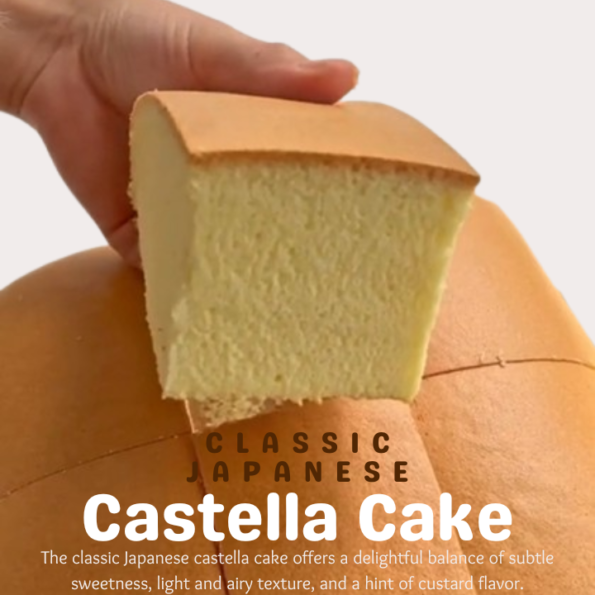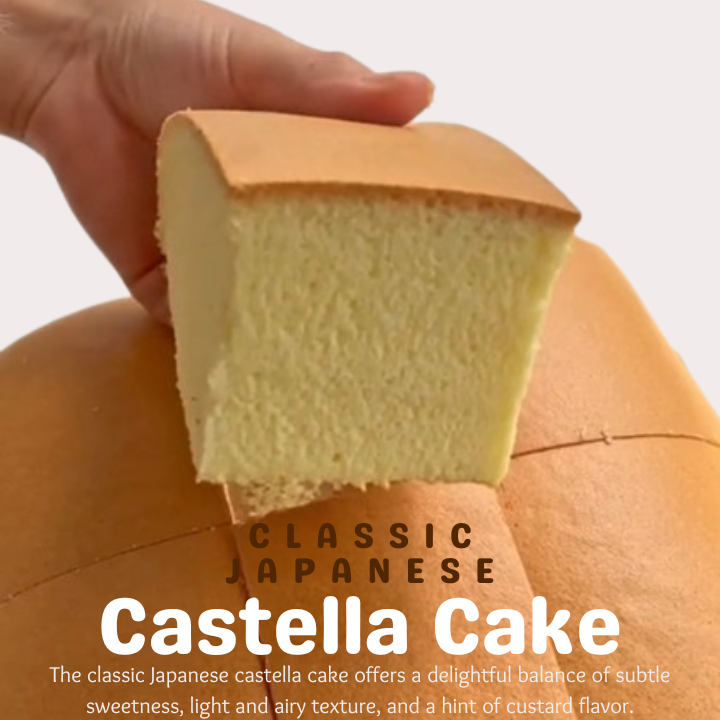
What Does Castella Cake Taste Like?

Have you ever stumbled upon a picture of a fluffy, golden cake online and wondered, "What does castella cake taste like?" Perhaps its delicate appearance and intriguing name have piqued your curiosity. Well, wonder no more! This comprehensive guide dives deep into the delightful world of castella cake, exploring its unique flavor profile, heavenly texture, and fascinating history.
Introduction: A Journey to Delectable Discovery
Castella cake, a delectable treat originating in Portugal, has become a beloved staple in Japan. This light and airy cake boasts a distinct flavor profile that sets it apart from other sweet breads and cakes. While its exact origins remain debated, some believe Portuguese missionaries introduced it to Japan in the 16th century. Made with simple ingredients like eggs, sugar, flour, and honey, castella cake embodies the philosophy of wagashi, traditional Japanese sweets known for their subtle sweetness and emphasis on natural flavors.
However, the unique characteristics of castella cake can sometimes leave people wondering exactly what it tastes like. Unlike its Western counterparts often loaded with sugar and frosting, castella cake offers a more nuanced taste experience. So, buckle up as we embark on a delicious journey to unveil the mysteries of castella cake's flavor and texture!
Unveiling the Flavor Profile: A Symphony of Sweetness
Castella cake's taste is a symphony of subtle sweetness, far removed from the intense sugary punch of many Western cakes. Here's a breakdown of the key elements that contribute to its unique flavor profile:
A Delicate Sweetness: Not Your Typical Cake
Castella cake differs significantly from most Western cakes in terms of sweetness. Instead of relying on heavy doses of refined sugar, castella cake traditionally uses honey or mizuame (a thick, clear syrup made from starch) as its primary sweetener. This results in a delicate sweetness that complements the other flavors in the cake, rather than overpowering them. Imagine a gentle whisper of sweetness on your palate, a delightful surprise compared to the usual sugary bomb.
The specific type of sweetener used can also influence the taste. Honey imparts a warm, floral sweetness, while mizuame adds a touch of caramel-like richness. This subtle variation allows bakers to tailor the sweetness level to their preference, ensuring a delightful experience for everyone.
Here's a table summarizing the impact of different sweeteners:
| Sweetener | Flavor Impact |
|---|---|
| Honey | Warm, floral sweetness |
| Mizuame | Caramel-like richness |
drive_spreadsheetExporter vers Sheets
Remember: Castella cake's charm lies in its subtle sweetness. It's a perfect treat for those who appreciate a more balanced and nuanced flavor profile.
Hints of Custard and Vanilla: A Luxurious Touch
Castella cake's flavor profile extends beyond just sweetness. Here's how other elements contribute to its delightful taste:
A Touch of Custard and Vanilla: A Luxurious Touch
As you take a bite of castella cake, you might be surprised by a hint of custard and vanilla. This luxurious touch comes from the generous amount of eggs used in the recipe. Whole eggs, separated and beaten to create air pockets, are a key ingredient in castella cake. The yolks contribute a rich, custard-like flavor, while the whites, whipped to stiff peaks, add lightness and a subtle vanilla aroma.
These delicate flavors dance on your tongue, complementing the sweetness from the honey or mizuame. The result is a luxurious taste experience that feels sophisticated yet effortless. Unlike cakes packed with artificial flavors and extracts, castella cake allows the natural flavors of its ingredients to shine through, creating a symphony of delightful sensations.
Here are some additional points to consider:
- The quality of the eggs used significantly impacts the final flavor. Fresh, high-quality eggs contribute to a richer custard flavor and a more enjoyable overall experience.
- Bakers sometimes add a touch of vanilla extract to enhance the natural vanilla aroma from the eggs. However, this is usually done sparingly to maintain the delicate balance of flavors.
A Touch of Savory: A Balancing Act
Castella cake's flavor profile might surprise you with a hint of something unexpected: savory. Don't worry, it's not a mistake! This subtle savory note adds complexity and depth to the overall taste experience. Here's how it comes about:
Eggs: The Secret Weapon of Savory Nuance
The same eggs responsible for the custard-like flavor also contribute a touch of savory. The separation of egg whites and yolks plays a crucial role. Egg yolks naturally contain compounds like lecithin, which can impart a slightly savory or "eggy" taste. While subtle, this hint of savory balances the sweetness from the honey or mizuame, creating a more intriguing and well-rounded flavor profile.
Imagine a gentle counterpoint to the sweetness, a whisper of savory that keeps your taste buds engaged. This unique characteristic is what sets castella cake apart from other desserts that rely solely on pure sweetness.
Here are some interesting facts about the role of eggs in castella cake:
- Japanese bakers traditionally use a higher ratio of egg yolks compared to Western sponge cakes. This contributes to a richer and slightly more savory flavor profile.
- Some recipes call for separating the eggs and beating the whites to stiff peaks. This not only adds volume but also helps to aerate the batter, resulting in a lighter and airier texture, which complements the subtle savory notes.
Texture Takes Center Stage: Light and Fluffy Perfection
Castella cake's charm extends beyond its captivating flavor profile. Its texture plays a vital role in creating a truly delightful eating experience. Let's delve into the secrets behind its heavenly lightness and airiness.
Cloud-like Texture: A Dream Come True
Imagine biting into a cloud – that's the closest sensation you'll get when you experience the texture of castella cake. It's incredibly light, airy, and fluffy, almost melting in your mouth. This dreamlike texture is achieved through a combination of factors:
- The Power of Eggs: As mentioned earlier, the separation and beating of egg whites play a crucial role. Whipping the egg whites to stiff peaks incorporates air into the batter, creating a spongy and airy structure.
- Minimal Fat: Castella cake contains minimal fat compared to other cakes. This lack of fat contributes to its lightness and prevents a dense or heavy texture.
- Baking Technique: The baking process also plays a part. Castella cake is typically baked at a high temperature for a short period. This quick bake sets the structure without drying out the cake, resulting in a light and fluffy final product.
The result? A delightful textural experience that feels like a gentle caress on your palate. Each bite is a celebration of airiness, a testament to the baker's skill and the magic of simple ingredients.
Moist and Delicate: A Delightful Bite
While light and airy, castella cake also boasts a delicate moistness. This perfect balance prevents the cake from becoming dry or crumbly. Here's what contributes to this delightful characteristic:
- The Role of Honey or Mizuame: These sweeteners not only add sweetness but also help retain moisture in the cake. They act as humectants, attracting and holding onto water molecules within the cake.
- Egg Yolks: The yolks contribute a touch of fat and moisture, adding richness and preventing the cake from drying out excessively.
The combination of these factors creates a moist and delicate crumb that complements the light and airy texture. It's a textural harmony that makes every bite of castella cake a truly enjoyable experience.
Variations on a Theme: Exploring Different Castella Styles
Castella cake, while known for its classic flavor and texture, boasts a surprising range of variations. These regional specialties and modern twists offer exciting flavor adventures for curious palates. Let's delve into some popular styles:
Classic Japanese Castella: The Benchmark of Perfection
The classic Japanese castella cake serves as the foundation for all other variations. It's a simple yet elegant dessert, showcasing the natural sweetness of honey or mizuame and the delicate flavors of eggs. This version is often enjoyed plain or with a dusting of powdered sugar, allowing the pure flavors to shine through.
Here are some key characteristics of the classic Japanese castella:
- Golden Brown Crust: The exterior boasts a beautiful golden brown color, achieved through caramelization of the sugars during baking.
- Light and Fluffy Interior: The inside is incredibly light, airy, and fluffy, offering a delightful textural contrast to the slightly crisp crust.
- Subtle Sweetness: The sweetness level is delicate and balanced, allowing the natural flavors of the eggs and honey to take center stage.
This classic version serves as a benchmark for appreciating the unique qualities of castella cake. It's a testament to the beauty of simplicity and the power of high-quality ingredients.
Modern Twists: Flavorful Adventures
The world of castella cake extends beyond the classic version. Modern bakers have embraced creative freedom, introducing delightful flavor variations that cater to diverse palates. Here are a few examples:
- Matcha Castella: This popular variation incorporates matcha powder, a vibrant green tea with a slightly bitter and earthy flavor. The matcha adds a unique twist to the sweetness of the cake, creating a delightful textural and flavor contrast.
- Chocolate Castella: Chocolate lovers rejoice! This version incorporates cocoa powder or melted chocolate into the batter, resulting in a rich and decadent flavor profile. The chocolate complements the subtle sweetness of the castella base, offering a satisfying treat.
- Fruity Castella: Fresh or dried fruits like berries, mangoes, or pineapples can be added to the batter or used as toppings. These fruity additions provide bursts of sweetness and tartness, creating a refreshing and vibrant experience.
These are just a few examples, and the possibilities are endless. With a little creativity, bakers can create unique castella variations that cater to specific tastes and preferences. Whether you enjoy classic simplicity or crave a flavor adventure, there's a castella cake waiting to be discovered!
The Perfect Pairing: Enjoying Castella Cake
Castella cake's versatility extends beyond its flavor and texture variations. It also pairs beautifully with a variety of accompaniments, enhancing the overall enjoyment. Here are some suggestions to elevate your castella cake experience:
Traditional Delight: Castella with Tea
For a truly authentic experience, pair your castella cake with a cup of green tea. The gentle bitterness and grassy notes of green tea perfectly complement the subtle sweetness of castella cake. The hot tea helps to cleanse the palate between bites, allowing you to fully appreciate the delicate flavors. Here are some specific green tea recommendations:
- Sencha: This classic green tea offers a refreshing and slightly vegetal taste that pairs beautifully with the sweetness of castella cake.
- Matcha: If you've opted for a matcha castella variation, pairing it with matcha tea creates a delightful flavor symphony. The earthy notes of matcha enhance the matcha flavor in the cake, resulting in a truly immersive experience.
Beyond green tea, other unflavored or lightly flavored teas like genmai (brown rice tea) or kukicha (twig tea) can also be delightful accompaniments.
Beyond Tradition: Creative Accompaniments
While green tea offers a traditional pairing, castella cake is versatile enough to enjoy with various accompaniments. Here are some creative ideas to consider:
- Whipped Cream: A dollop of fresh whipped cream adds a touch of richness and creaminess to the light and airy cake. You can even infuse the whipped cream with a touch of vanilla extract or fruit for an extra flavor dimension.
- Ice Cream: Elevate your castella cake into a decadent dessert by pairing it with a scoop of your favorite ice cream. Vanilla, matcha, or even fruit-flavored ice creams create delightful flavor combinations.
- Fresh Fruits: Sliced fresh fruits like strawberries, mangoes, or blueberries add a burst of sweetness, tartness, and vibrant color to the cake. The contrasting textures create a dynamic and refreshing eating experience.
Ultimately, the perfect pairing for your castella cake depends on your personal preference. Experiment with different options and discover what tantalizes your taste buds the most!
Conclusion: The Allure of Castella Cake
Castella cake, with its captivating flavor profile and heavenly texture, offers a delightful escape from the world of overly sweet and dense desserts. We've embarked on a journey to unveil its mysteries, exploring its:
- Subtle Sweetness: A departure from sugary overload, castella cake relies on honey or mizuame for a delicate sweetness that complements other flavors.
- Hints of Custard and Vanilla: The generous use of eggs adds a touch of rich custard and a whisper of vanilla, creating a luxurious taste experience.
- Balancing Savory Note: The subtle savory nuance from egg yolks adds complexity and depth, preventing the cake from becoming one-dimensional.
- Light and Fluffy Perfection: Whipped egg whites and minimal fat contribute to a cloud-like texture that melts in your mouth.
- Moist and Delicate: Honey or mizuame and egg yolks ensure a moist and delicate crumb, adding to the delightful mouthfeel.
From the classic Japanese version to modern variations with matcha, chocolate, or fruit, castella cake offers a world of flavor exploration. Whether enjoyed plain with a cup of green tea or dressed up with whipped cream and fresh fruit, castella cake is a versatile treat that caters to diverse palates.
So, the next time you encounter a picture of this intriguing cake, remember, castella cake is more than just a pretty face. It's a symphony of flavors and textures, a delightful journey for your senses. Why not embark on your own castella cake adventure and discover its unique charm for yourself?
Did you know?
Why Do Americans Eat Ham on Easter?

Watch Video: Classic Japanese Castella Cake Recipe
The classic Japanese castella cake offers a delightful balance of subtle sweetness, light and airy texture, and a hint of custard flavor.
- 6 large eggs, separated
- 1 cup granulated sugar (200g)
- 1/2 cup honey or mizuame (120ml)
- 1 cup cake flour (125g)
- 1 teaspoon vanilla extract (optional)
- 1/4 teaspoon salt
- Preheat the oven to 320°F (160°C). Line an 8x8 inch baking pan with parchment paper.
- Separate the eggs. In a large bowl, whisk together the egg yolks, honey or mizuame, and vanilla extract (if using) until light and fluffy.
- Whip the egg whites. In a separate bowl, using an electric mixer with a whisk attachment, beat the egg whites with the salt on medium speed until soft peaks form. Gradually increase the speed to high and beat until stiff peaks form. The peaks should hold their shape when the whisk is lifted.
- Combine gently. Using a rubber spatula, gently fold 1/3 of the whipped egg whites into the yolk mixture. Mix until just incorporated. Gently fold in the remaining egg whites in two batches, taking care not to deflate the batter.
- Sift in the flour. Sift the cake flour into the batter and gently fold it in with a rubber spatula until just combined. Be careful not to overmix, as this can result in a dense cake.
- Pour and bake. Pour the batter into the prepared baking pan and gently smooth the top. Bake for 40 minutes, or until a toothpick inserted into the center comes out clean.
- Cool and enjoy. Let the cake cool completely in the pan before cutting and serving. Dust with powdered sugar for an extra touch of sweetness (optional).
- Amount Per Serving
- Calories 220kcal
- % Daily Value *
- Total Fat 3g5%
- Saturated Fat 1g5%
- Cholesterol 90mg30%
- Sodium 35mg2%
- Total Carbohydrate 38g13%
- Sugars 25g
- Protein 5g10%
* Percent Daily Values are based on a 2,000 calorie diet. Your daily value may be higher or lower depending on your calorie needs.
- Use high-quality, fresh eggs for the best results.
- Make sure the egg whites are at room temperature for optimal whipping.
- Do not overmix the batter. A few streaks of flour are okay.
- The cake may rise slightly during baking and then sink a bit in the center as it cools. This is normal.



